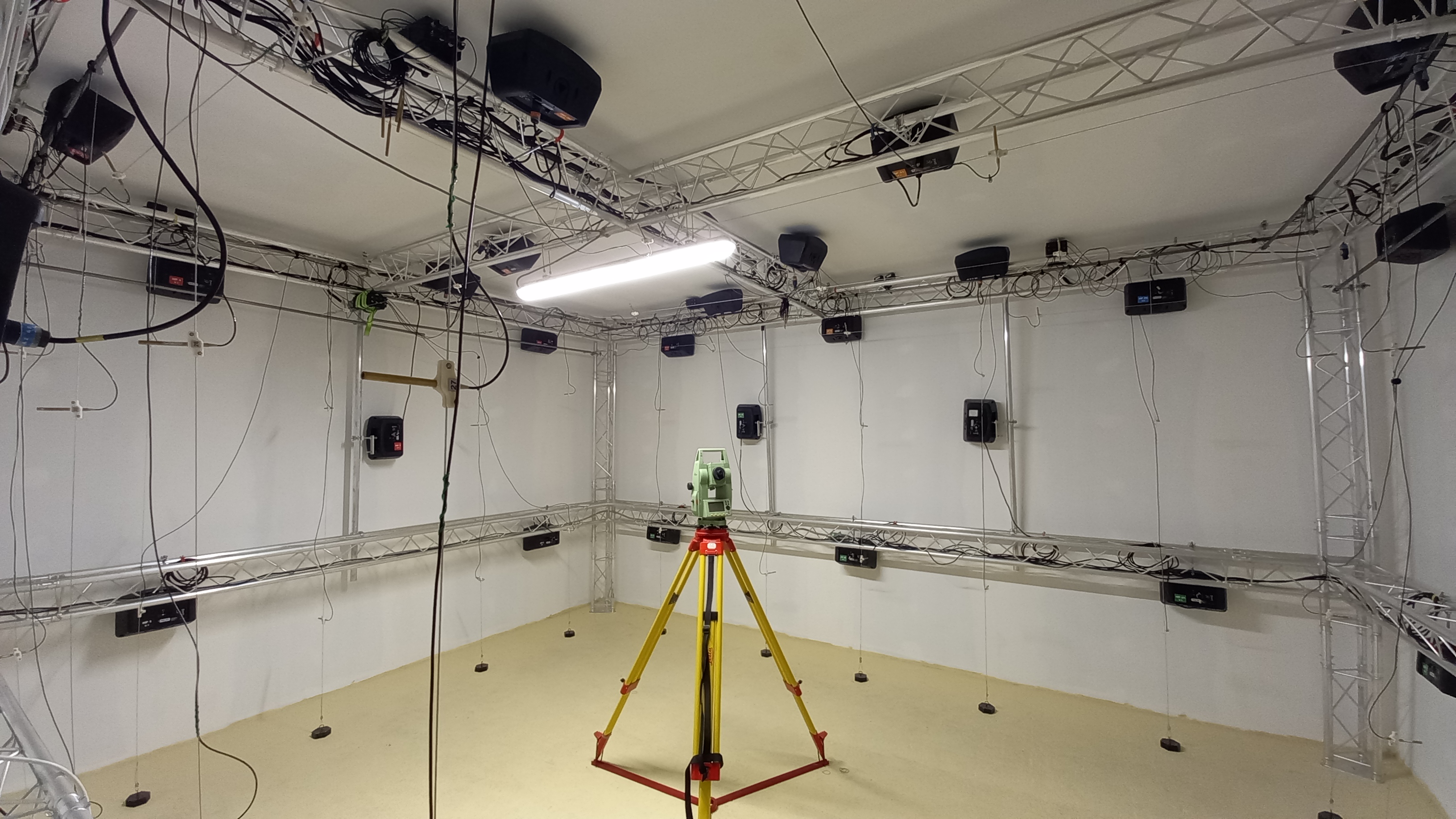Acoustic field synthesis and control
This theme covers the laboratory's activities in the field of acoustic field reproduction, using multichannel electroacoustic devices, as well as noise control using passive materials or systems, linear or non-linear, or active devices.
Current and future projects within this theme include theoretical and numerical aspects related to the design of restitution or control devices, but they all have a strong experimental component. These projects make use of the laboratory's extensive facilities (in particular the anechoic chambers of the Plateforme Science Innovation Vibro-Acoustique, accredited by the University of Aix-Marseille) and the team's wide range of skills in acoustic metrology, sound recording and the design and manufacture of audio equipment.
Permanent members : R. Côte (MCF), A. Coutant (CR), E. Friot (CR), P.O. Mattei (CR), S. Meunier (CR), C. Maury (Prof), M. Pachebat (IR), C. Pinhède (IR), G. Rabau (IR)
Acoustic field synthesis
|
Our work focuses on reproducing, in a controlled acoustic environment, the vibroacoustic response of insulating structures subjected to complex turbulent boundary layer-type excitation pressure fields, which are often difficult or costly to characterise in situ (flight tests) or using dedicated infrastructures (anechoic wind tunnels). The innovative concept is to be able to synthesise complex excitations (weakly correlated, inhomogeneous) using a source scanning method, without being limited by the number and position of sources. The test facility, currently located in the semi-anechoic chamber of the LMA, consists of a robotic antenna of virtual sources, controlled to reproduce complex loads on flat or curved academic or industrial structures. In particular, the antenna can be used to reproduce a diffuse field at low frequencies for the analysis of transmission losses in insulating structures, which is impossible to achieve with conventional reverberant volumes; ANR VIRTECH PhD Augustin Pouye |
 |
|
A broadband acoustic field synthesis room (from 3 Hz) has been designed and built to study the perception of low and very low frequency sounds. This room makes it possible to study sound perception under perfectly controlled conditions at very low frequencies, where perception mechanisms are poorly understood. Broadband and unsteady noises (e.g. a supersonic bang) can be reproduced at supraliminal levels. Another line of development, which would make it possible to reproduce pure low-frequency sounds at even higher levels, is to pre-compensate for the distortion of low-frequency sources, since it is this distortion, through audible harmonics, that limits the control levels at which sound perception can be studied below 10 Hz. Projet ANR RIBEolH (Research into the Impacts of Wind Noise on Humans) Post Doc Ossen El Sawaf |
 |
Passive noise reduction
|
Micro-perforated materials LabeX 2017-19, A*Midex - IMI 2022-23, collaboration inter-laboratoires LMA (CM, CP) – IRPHE – CSIC Madrid] |
 |
|
Non-linear Passive Absorbers The passive vibroacoustic nonlinear absorber (NES for Nonlinear Energy Sink) consists of a thin circular viscoelastic membrane with high deformation. It is used to control an acoustic field in the vicinity of the first acoustic mode of a tube open at both ends and excited by a loudspeaker. A simplified model of this device has been developed. A series of analytical developments, parametric identification methods and measurement tools are used to identify and understand the main energy exchange mechanisms between the primary system and the absorber. Examples of non-linear vibro-acoustic passive absorbers |
 |
| We have developed an NES concept with nonlinear stiffness and damping that has found application in very low-frequency (sub-Hertz) vibration control of wind turbines to reduce mechanical fatigue, through a collaboration between LMA and Total-TTE. This led to a substantial contract, the purchase of equipment, the hiring of a post-doc for 2 years, experiments using the platform, the writing of several articles and the filing of a patent. These very low-frequency NESs are also the subject of a post-doc's participation in the France-Energie-Marine AFOSS-DC industrial project, which focuses on the vibration control of offshore wind farm substations. |
 |
|
Topological insulator The development and study of topological acoustic insulators in acoustic waveguide network. Different types of topological modes and their properties are studied: edge modes in 1D or 2D systems, or defect modes. For example, experimental characterization of topological defect modes has been carried out using a tube-and-connector array on a hexagonal bilayer network (opposite). Experimental characterization of topological defect modes |
 |
Active noise reduction
|
A strategy for controlling the acoustic field reflected by the walls of a room is developed both theoretically and experimentally. One of the difficulties lies in identifying the “G” filter for estimating the scattered pressure from total pressure measurements. The original method, known as “active anechoicity”, consists of two stages: identification of the scattering filter “G”, then implementation of active control to cancel the scattered pressure. A demonstrator for a hybrid passive/active semi-anechoic room is currently under development, and involves supplementing the absorbent wall cladding with auxiliary sources (anti-noise) to cancel out residual echoes (not absorbed by the cladding). DADA project funded by IMI, Region |
 |